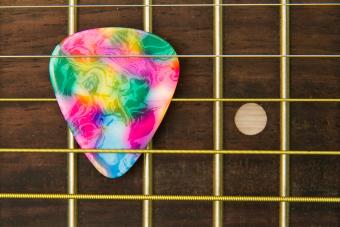
Some people prefer guitars with low action. Action, in this case, refers to the distance between the strings and the fret board of the guitar. High action means the strings are farther away from the frets; therefore, it's harder to hold down the strings and play them. Low action means the strings are much closer to the guitar and easier to play.
Who Needs a Low Action Guitar
There are many things to consider when purchasing a guitar from aesthetics to quality, tone, budget, and more. The player's level and ability are also a consideration. For a guitarist just getting started or at an intermediate level, a guitar with low action could be quite helpful as the pressure required to fret notes will be considerably less. A guitar with low action and a lighter gauge of strings, perhaps .08 or .09 on the high E string, will present little resistance to your hands. The downside of this, of course, is the sound with lighter strings is a bit thinner and has less bottom and mid-range tone. Other players who may prefer or even need a guitar with lower action are solo or lead guitarists or bluegrass pickers. To improvise and play a lot of notes at fast tempos is quite difficult on a guitar with high action.
What to Look For
Many companies from Yamaha, Washburn, and Alvarez to Taylor and Martin make quality beginner or intermediate model acoustic guitars. Any guitar with a truss rod and bridge can be adjusted to get the action desired. Give consideration to the fact that if the action goes too low, the strings will buzz and sound quite awful. Qualified luthiers are recommended to do any action work on guitars. When shopping for a guitar use the following checklist:
-
Check the action, especially towards the sound hole and at the higher frets.
-
Make sure the distance between fret and string is the same all the way up the neck - otherwise there is already a problem.
-
Use a tuner and/or your ear to check the intonation of the strings in every part of the guitar.
-
Make sure the place you are buying the instrument can set up the action exactly how you want before you leave. If they can't, purchase the guitar elsewhere.
When to Upgrade
If a guitarist is comfortable with the way the guitar looks, as well as its tone and sound, and he is making great music on it, there is no reason to think an upgrade would be necessary simply due to the guitar's action. If, however, a guitarist begins to write and record or perform regularly, an upgrade may be needed.
Guitars Suited to Low Action
Of the brand names already mentioned, Yamaha, Alvarez, and Washburn make solid instruments in a lower price range that can be adjusted to low action. Taylor and Martin are more high end and expensive.

- The Yamaha FG800 is an inexpensive and solidly built acoustic guitar. With its slim tapered neck, durability, and sound, it's a great for a beginner guitarist on a budget.
- The Alvarez RD266SCESB Dreadnought is an acoustic with built-in electronics for live performance and recording. A step up from the Yamaha in price and features, this guitar also has a slim neck for ease in playing.
- The Washburn WCG18CE Comfort Select Grand Auditorium is also an acoustic-electric. For a few dollars more, this instrument comes with the renowned Fishman electronics and a cutaway to get at the higher frets with ease.
- The Taylor 100 Series 2016 114ce Grand Auditorium is a creme-of-the-crop type guitar in the $800 price range. High end craftsmanship, fine woods, and overall excellence come with this guitar. The truss rod will make adjusting the action easier.
- The same superlatives apply to the Martin Custom D Classic Mahogany Dreadnought. This guitar is a little more expensive and does not have a cutaway, so this instrument is best suited for rhythm players and singer songwriters.
Getting the Right Guitar
After careful research and with help of looking at the guitars linked above, this is still a very personal preference. Some guitarists may like low action, some high. Stylistic considerations will vary among players. Some guitar players want to write songs and record while others are looking to play live. It is up to the guitar player to experiment with a few to see what kind of guitar is right for him or her. The important thing to remember is that the action of the guitar is more a matter of personal choice then something that has to be adhered to. The benefits to the beginner guitarist are, however, very clear. Acoustic guitars that have low action generally make for easier playing and learning.







